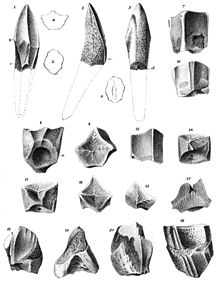Trachodontinae
|
Trachodon Temporal range: Late Cretaceous, 77 Ma |
|
|---|---|
 |
|
| Illustration of the isolated teeth | |
| Scientific classification | |
| Kingdom: | Animalia |
| Phylum: | Chordata |
| Clade: | Dinosauria |
| Order: | †Ornithischia |
| Suborder: | †Ornithopoda |
| Family: | †Hadrosauridae |
| Genus: |
†Trachodon Leidy, 1856 |
| Species: | †T. mirabilis |
| Binomial name | |
|
Trachodon mirabilis Leidy, 1856 |
|
| Synonyms | |
|
Diclonius mirabilis (Leidy, 1856) |
|
Diclonius mirabilis (Leidy, 1856)
Trachodon (meaning "rough tooth") is a dubious genus of hadrosaurid dinosaur based on teeth from the Campanian-age Upper Cretaceous Judith River Formation of Montana, U.S. It is a historically important genus with a convoluted taxonomy that has been all but abandoned by modern dinosaur paleontologists.
Despite being used for decades as the iconic duckbill dinosaur per antonomasia the material it is based on is composed of teeth from both duckbills and ceratopsids (their teeth have a distinctive double root), and its describer, Joseph Leidy, came to recognize the difference and suggested limiting the genus to what would now be seen as ceratopsid teeth. Restricted to the duckbill teeth, it may have been a lambeosaurine.
In 1856, Joseph Leidy received fragmentary remains from the Judith River Formation, collected by Ferdinand Vandeveer Hayden. From these bones, he provided the first names for North American dinosaurs: Deinodon, Palaeoscincus, Trachodon, and Troodon (then spelled Troödon), the latter being the only name still in use. The type species of Trachodon is T. mirabilis. The generic name is derived from Greek τραχυς, trakhys, "rough", and όδον, odon, "tooth", referring to the granulate inner surface of one of the teeth. The specific name means "marvelous" in Latin.
...
Wikipedia
